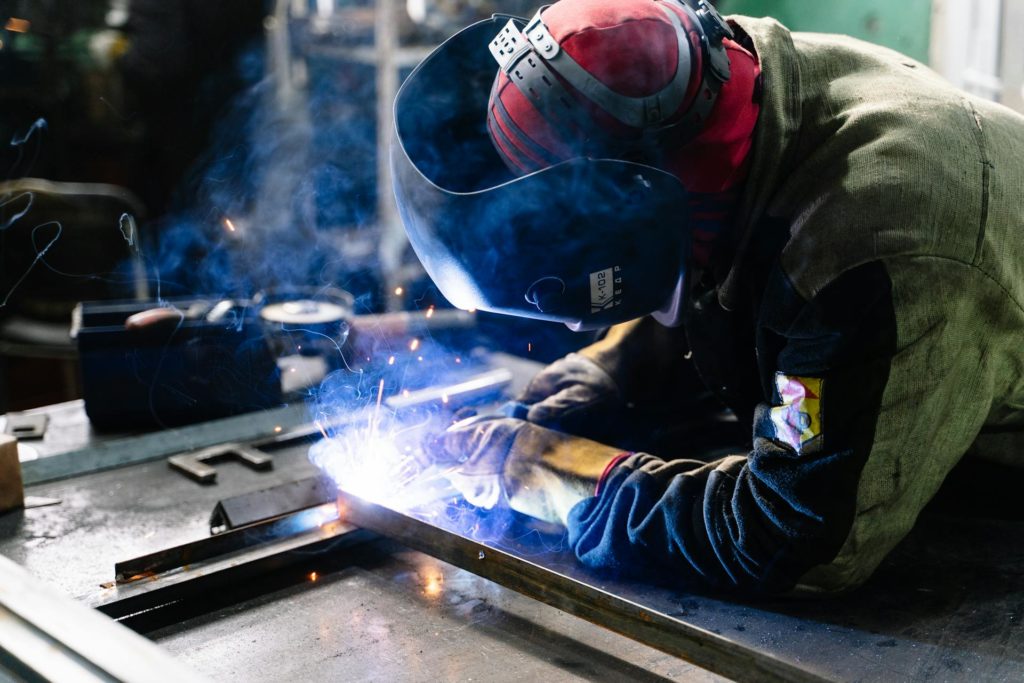
Welding and fabricating are powerful skills that let you build and repair almost anything made of metal. Safety should always be your top priority When working on a small project in your garage or tackling a bigger job in a workshop. In this article, we’ll review some essential safety tips to help you stay safe while working.
1. Wear the Right Gear
You must ensure you’re dressed for the job before you even think about striking that first arc. Welding and fabricating expose you to intense heat, bright light, and flying sparks, so wearing the right gear is necessary.
- Welding Helmet: This is probably the most iconic piece of welding equipment. A welding helmet protects your eyes and face from the bright light and sparks. Make sure it has the correct shade to protect your eyes from harmful UV and infrared rays.
- Gloves: Your hands are closest to the action, so they must be protected. Use thick, flame-resistant welding gloves to protect your hands from heat and sparks.
- Protective Clothing: Wear flame-resistant clothing that covers your arms and legs completely. Avoid synthetic fabrics, as they can melt and cause severe burns. Instead, go for heavy cotton or specially designed welding jackets and pants.
- Footwear: Steel-toed boots with rubber soles are the best option to protect your feet from falling objects and electrical shocks.
2. Keep Your Workspace Clean and Organized
A cluttered workspace can lead to accidents. Before welding or fabricating, tidy up your area for a few minutes.
- Remove Flammable Materials: Clear away anything that can catch fire, like paper, wood, or chemicals. Sparks can fly quite far, and the last thing you want is to accidentally start a fire.
- Organize Tools and Equipment: Keep your tools and equipment organized and within easy reach. This will make your job easier and prevent tripping over stray tools or cables.
- Ventilation: Welding produces fumes that can be harmful if inhaled. Make sure your workspace is well-ventilated, or use a fume extractor to keep the air clean.
3. Understand Your Equipment
Before you start welding, knowing your equipment inside and out is important. This knowledge can prevent accidents and help you work more efficiently.
- Read the Manual: Every piece of equipment comes with a manual, and it’s worth taking the time to read it. Understanding the ins and outs of your welder, grinder, or cutter can help you use it safely.
- Inspect Your Tools: Before you begin, inspect your equipment for any signs of wear or damage. Check cables for fraying, ensure connections are secure, and ensure all moving parts work smoothly.
- Proper Settings: Make sure your equipment is set up correctly for the type of work you’re doing. Incorrect settings can lead to poor welds, equipment damage, or even accidents.
4. Protect Yourself from Electrical Hazards
Welding and fabricating involve electricity, which comes with its dangers. Being mindful of these hazards helps keep you safe.
- Avoid Wet Conditions: Water and electricity don’t mix. Never weld in wet conditions, and make sure your hands and work area are dry.
- Ground Your Equipment: Properly ground your welding machine to avoid electrical shock. Always ensure the ground clamp is securely attached to your workpiece or table.
- Use the Right Cables: Ensure your cables are rated for the power your machine requires. Using the wrong cables can cause overheating and increase the risk of electrical fires.
5. Fire Safety First
Welding produces sparks and intense heat, so fire safety should always be on your mind.
- Have Fire Extinguishers Ready: Keep a fire extinguisher nearby, and make sure it’s the right type for welding. A Class C or ABC extinguisher is typically recommended.
- Watch for Sparks: Sparks can travel farther than you think. Keep an eye on where they land, and use welding blankets or shields to protect nearby objects.
- Cool Down Period: After welding, give your workpiece time to cool down before moving it. Hot metal can easily start a fire if it comes into contact with flammable materials.
Closing Thoughts
Welding and fabricating can be incredibly rewarding but also have risks. Following these safety tips can protect yourself and those around you while working. Safety is not just about wearing the right gear; it’s about being aware of your environment, understanding your equipment, and being prepared for anything.


